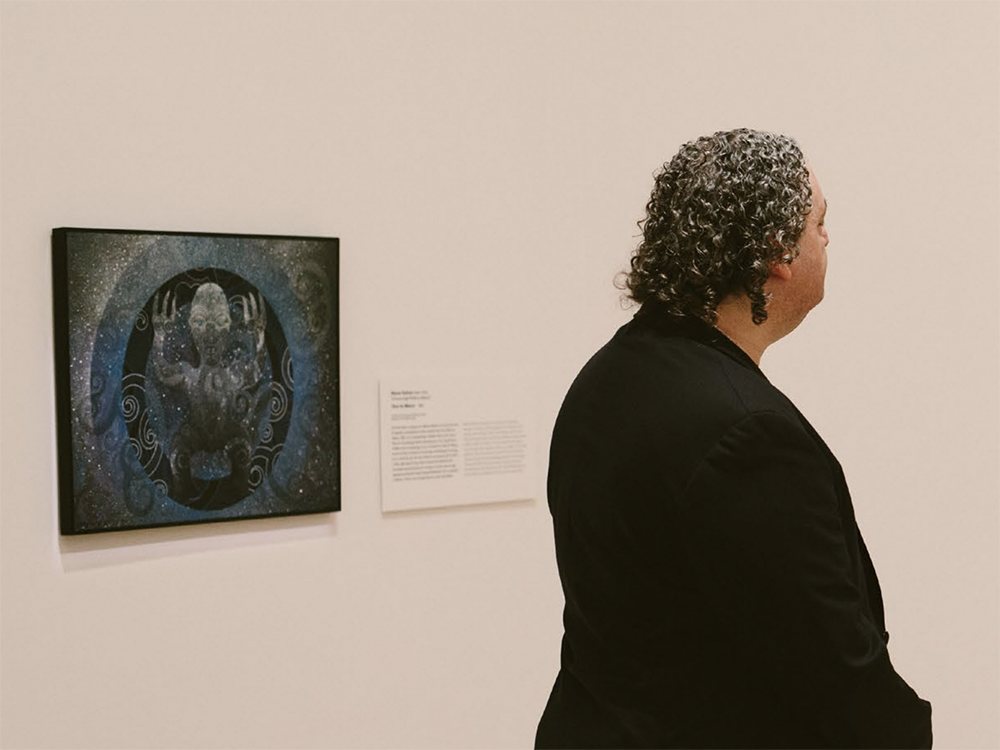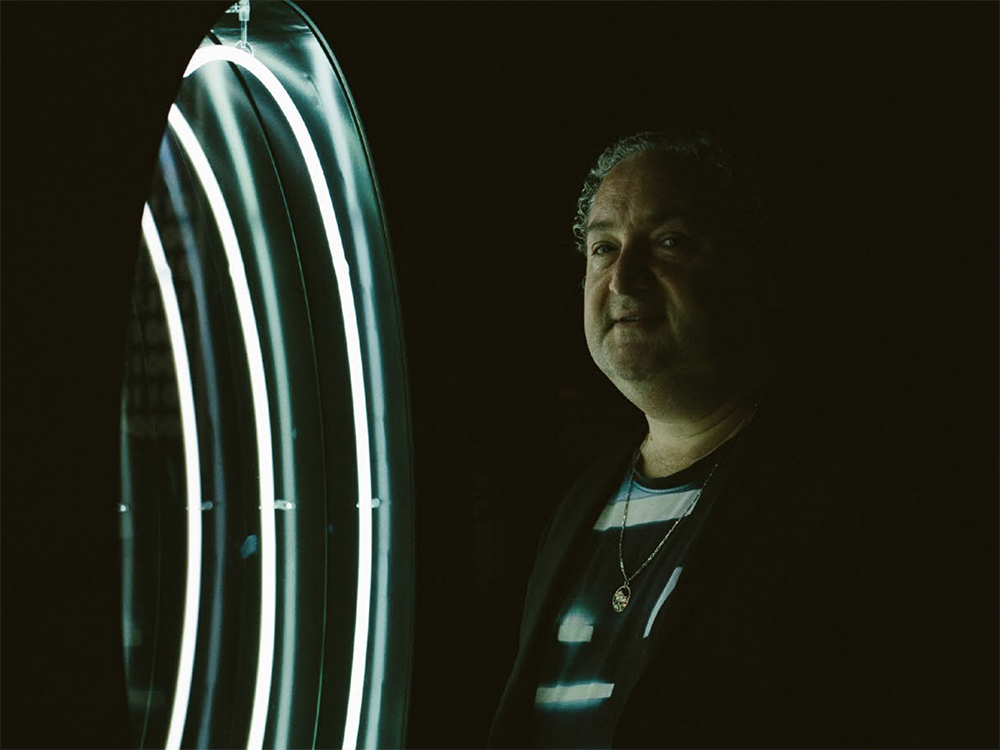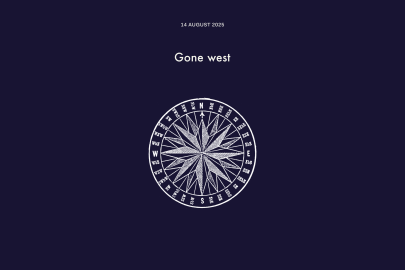Feb 26, 2021 Arts
Note: Since the writing of this piece, Nigel Borell has resigned from the Auckland Art Gallery and is no longer its curator of Māori art.
Auckland Art Gallery’s upcoming show Toi Tū Toi Ora: Contemporary Māori Art will be the first of its kind in Aotearoa in almost 20 years and, for the gallery, it will be the biggest showcase of contemporary Māori art in its 132-year history, taking up the entire exhibition space for the first time ever.
With roughly a hundred artists and more than three hundred works (including nine or so new commissions), the exhibition will be something of a landmark and a challenge to the New Zealand mainstream’s apprehension of contemporary Māori art, which, to date, ranges from oblivious and indifferent, to blatantly avoidant.
When there is mainstream interest in contemporary Māori art, it’s often as an adjunct to a post-crown New Zealand-ness as a whole, and never spotlit as having inherent value beyond this agenda of national identity-making. Consequently, the visibility of Māori cultural forms in this country has taken various guises, not least of which has been kitschy reimaginings (appropriations) of Māori visual lexicons by the likes of Dick Frizzell, which, love them or hate them, have made their way into the collective zeitgeist with the cunning pervasiveness of a summer cold. All of which poses some significant questions for the movement itself, like, what constitutes contemporary Māori art? For example, do Frizzell’s tiki paintings or even Theo Schoon’s koru-patterned murals qualify as Māori because of the mere presence of Māori forms? Or, are these just cosmetic flourishes belonging to a thieving ‘pop’ art, and is it authenticity and authorship which end up staking claims to a Māori canon? And, just who is the delineation of a Māori art canon relevant to? Māori? Pākehā? Both?
We’ve come a long way since European masters used ‘primitive’ bodies as romantic subjects willy-nilly, rendering ‘the savage’ as a noble example of ‘nature in a pure state’ (oh god). Perhaps the most pressing shift since then has been that Māori bodies have been able (with a certain amount of institutional resistance) to upend this dynamic and take their own place on the artist’s side of the easel. So, contemporary Māori art can perhaps be defined by these things only: that it’s authored by Māori, that contexts and narratives surrounding the works orbit a decidedly Māori authority, that Māori be entitled to addressing their own issues in their own ways, and not be circumscribed by a European lens which to date has mediated Māori cultural forms almost to the point of erasure.
But, as with any minority culture attempting to overcome a periphery status, it’s not just aesthetic practices and signifiers our aspirationally multicultural society risks losing, but also the unique world views that come attached to these — world views that we may need to consider more seriously in the current global ambience of crisis and collapse.
It is the hope of Nigel Borell, who was recently appointed curator of Māori art at Auckland Art Gallery, that Toi Tū Toi Ora: Contemporary Māori Art will address these and other questions in a way which is both evocative and inciting — vetting potentially diff icult conversations he sees the culture needing to have — but also accessible. I sat down with him recently to talk about his excitement for the landmark show, and his nervous yet hopeful projections for how it will be received.

Photo by Jo Currie.
SAMUEL TE KANI: How did the show come about?
NIGEL BORELL: It’s an exhibition that I pitched when I interviewed for the job back in 2015. You had to theoretically pitch three shows that you’d like to see take place at the gallery and, for me, because it had been 15 years or so since the last survey show of contemporary Māori art, it was really important that we checked in with contemporary Māori art as a movement and put a spotlight on those artists who have come around since.
When was the last survey show?
There were two. There was one here in 2001, called Pūrangiaho: Seeing Clearly, which was co-curated by Ngahiraka Mason and Ngarino Ellis. The other survey show was in 2002 at Te Papa, Taiāwhio: Continuity and Change. So since 2001 here at the Auckland Art Gallery, we haven’t had another exhibition looking at the breadth of Māori art and checking in with who is doing what today.
For me, it was really important that I was pitching the shows that I would like to see happen, and with blue-sky thinking, it was definitely to revisit the importance of contemporary Māori art in a survey show. But, like anything with time, how we think about contemporary Māori art had moved. I was no longer interested in framing it around a Western art canon that talked back to Western art history as its point of circumference, you know? That ship has sailed as far as I’m concerned.
Do you think New Zealand has changed significantly since then?
Would you speculate that we’re more open to the idea of contemporary Māori art now than we were at the beginning of the new millennium? Yeah, absolutely. There’s been a significant shift in the discussion and an acceptance of a broader view of culture and of Māori art, and also of the place of claims-making and authorship within that space. With those last two survey shows, you could say it was still up for grabs, the territory around how we think about presenting those types of exhibitions from a Māori world view, and, at that point in time, we had only just received Māori curatorial roles in this institution, and similarly at Te Papa. So it’s no coincidence that once Māori have the ability to tell these stories, guess what: they’re gonna tell them diff erently to how the mainstream has told them beforehand.
It’s important to register that we own those stories differently, and we’re quite unapologetic about the fact that our nucleus sits here and this is the area of interest that we want to move you to, not you move us to. So I think the politics of that has been more explicit over time, though I still feel there are challenges around ownership. And to me that’s a challenge for the institution. The other thing is realising when you have the opportunity to effect change or to turn the page in terms of some of those stories. Then you’ve got to seize it and take the opportunity.
To date, most opportunities have been presented to Māori as ‘reparations’.
Reparations are very slim pickings anyway. It’s not like the pie is that huge to start with. So I think Māori are incredibly resourceful for what we do with the slice of the pie we end up getting. The post Treaty-settlement environment is going to be an interesting one for iwi and for Māori generally in how we seize opportunity. But I feel sometimes we have to practise owning space even if it’s in our own head to start with, and then owning it physically like we are trying to do with this show, and then shift the thinking to this paradigm; not for them to try and make our paradigms fi t their dominant culture. So you’ll see, quite literally, with the show that we do that with the creation story where we ask visitors to navigate how Māori see the world, and, of course, people are more than willing to take that journey and to learn something new because the other thing in the world today is that we’ve exhausted certain avenues of understanding and explaining the shit we’re in, and it just so happens that indigenous ideas of treading on the Earth have come back around as really profound ways of looking aft er your footprint — especially now the environment is in such a precarious position. This is the only way you can survive — to work with the environment. I think people realise that what’s driving some of those things around greed and around power is the lack of ability still for the dominant culture to share power.
It’s such a massive show with so many different works and artists. What’s your selection process?
I was really guided by presenting the show that I would want to come and see. I was guided by what I thought was important, but also in trying to fi gure through the things all these artists have in common as a survey show; and the baselines and the beats that started to come forward was the idea of the creation story, however differently Māori might see that story because it’s quite nuanced from tribe to tribe. Even so, I could use it to forge us all forward, in one voice but also still enclosing lots of nuanced ways of thinking about it; a unifi er, and by extension an entry point into Māori culture and knowledge that suspended a reliance on Western art canon as a way to orientate and validate contemporary Māori art practice.
Does the choice to theme the show with a Māori creation story, as a rejection of Western theology, contain a message about Māori sovereignty?
Absolutely. Every move in this gallery is a political act when you’re Māori, no matter what you’re putting on display. Using the creation story was a way of saying, “Well, actually, I know you think there’s only one way to see this art but we’re going to turn this upside down and privilege the Māori world view first.”
Some of the artists are explicitly looking at these ideas and some only implicitly, but either way we’re going to privilege the Māori world view this time and let all the other conversations be secondary. Oft en in this building it’s the other way around, where the Western art canon is the dominant conversation. All I’ve really done is turn it on its head.
There’s been something of a renaissance with Pasifika art and it’s felt like it’s been getting more attention and resources than Māori art. Could you speak to that, as a curator?
That’s a very good question. Māori and the Crown have a very diff erent relationship from that of those who have immigrated here as a second home but maintain a strong sense of their culture. For Māori, as tangata whenua we will always have a different relationship with the coloniser than they will. We have a different relationship to this land. And a little bit like the show, we have a unique position that can’t be replicated anywhere else because it’s shaped by our colonised history, which we’re also invested in understanding.
Pasifika art is vibrant and healthy and extremely visible, and I think we need to get out of an us-and-them debate that oft en happens, because it’s not healthy for either party. But, at the same time, I think it’s good to differentiate how we are as tangata whenua different from our Pacific cousins, and again, I think it’s the authority that we bring to bear on our relationship with this land as indigenous people. The ability to have authority in your own land is ultimately what needs to be understood in that dynamic, and not to play the brownies off one another, which the powers that be have a tendency to do, making good brownies and bad brownies.
How long have you been thinking about the show?
Four years. Obviously this has been a really crazy year, but it’s been a blessing, too, if I can say that. It’s really allowed us to put the focus on local programming in a big way because all the international shows got killed off by Covid.
So we have to wait for a global pandemic for an institution to have the incentive to put on a local show?
Well, we were already doing the show but as soon as the others got cancelled, the gallery took it on in earnest. The other thing with our institution is we’ve got an amazing talented team across the gallery, from conservators, registrars, technicians to display artists and a curatorial team, and it’s been amazing being in the eye of the storm as curator seeing everyone working on one project, which in this institution we hardly ever do because we’re normally putting on four or five shows at any one time. It’s been so cool that all the momentum’s behind this one exhibition. And if it’s the largest we’ve ever produced in 132 year history then yeah, we need all that momentum.






